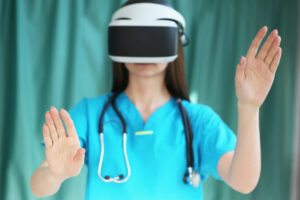Health Training Through Augmented Reality
Driven by technology, a new learning model is emerging that provides access to knowledge at low cost. Here is an overview of its use and implementation.

In rural and remote areas of Latin America, access to health education is scarce and often a privilege. Distance, lack of infrastructure, and limited medical personnel mean that communities do not receive up-to-date information on prevention, first aid, or basic care. Technology is becoming a key tool for public health through the incorporation of augmented reality (AR).
Augmented reality is transforming how community health promoters receive training, even in areas with limited infrastructure and connectivity, using only simple technologies such as headsets, apps, or smartphones. With this technology, it becomes possible to learn how to identify symptoms, administer vaccines, or respond to basic emergencies in an immersive, educational, and locally adapted way.
Learning by Doing with Technology
Unlike traditional teaching methods, augmented reality allows digital information—graphics, animations, or interactive instructions—to be superimposed on the physical environment. With this method, a person can view a three-dimensional model of the human body, practice medical procedures, or visualize how a drug moves through the body—all in real time.
In rural areas of Argentina, Peru, and Colombia, this tool is being used in pilot programs designed to train community health promoters without requiring classroom attendance, significantly reducing costs. One example can be found in northern Argentina, where a group of social organizations and private foundations are funding the implementation of AR modules to train health agents in preventing endemic diseases such as dengue or Chagas.
The goal is to provide tools that enhance local capacity without depending exclusively on the presence of instructors or health professionals. This model is expanding rapidly, as training for rural health promoters continues to face an educational gap. Many volunteers and community agents lack prior medical training and stable internet access. For this reason, augmented reality has become a highly valuable tool, offering applications that can operate offline and do not require expensive equipment.
Training sessions follow a visual, intuitive, and hands-on approach. For example, in a first aid module, animations are projected to highlight the correct steps for performing cardiopulmonary resuscitation (CPR) on a virtual figure. Another module teaches how to recognize signs of dehydration in children through interactive simulations where users must make quick decisions in emergency scenarios.
The growth of this type of model depends on support from private donors and foundations that see technology as a vehicle for inclusion. These actors focus on boosting projects of this kind, and in many cases, funding comes from tech companies seeking to create social impact beyond the market. In 2024, the Meraki Foundation and Tech4Good Global jointly launched the Augmented Health program, which currently trains over 300 community promoters in northern Peru and southern Ecuador.
Each participant in the program receives a mobile device preloaded with educational content and a basic health tools kit. However, one of the keys to AR’s success in these programs lies in the cultural and linguistic adaptation of content. In indigenous communities of the Chaco or the Amazon, for instance, training modules include narrations in native languages and examples based on real-life local situations.
This approach not only improves understanding but also strengthens the connection between technology and local identity, turning health promoters into agents of change. The incorporation of AR therefore goes beyond mere technological adoption—it represents a paradigm shift. It brings knowledge directly into communities and democratizes access to health education without relying solely on public systems, creating networks of care that operate from the grassroots, empowered by innovation.
As device costs fall and applications become more accessible, augmented reality is gaining ground as a foundational tool for health education. The public health of the future may no longer depend solely on hospitals or ministries but also on simple, accessible, and powerful tools that enable communities to learn, care, and teach from anywhere.


